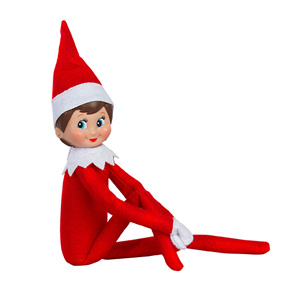Santa’s Lousy Prison Guard: The Elf on the Shelf
 Is the Elf on the Shelf teaching children to enjoy, and submit to, a world of surveillance? A recent article in The Washington Post that’s been doing the rounds in my Facebook feed cites Laura Pinto and Selena Nemorin’s “Who’s the Boss? ‘The Elf on the Shelf and the Normalization of Surveillance” saying yes. They’re wrong.
Is the Elf on the Shelf teaching children to enjoy, and submit to, a world of surveillance? A recent article in The Washington Post that’s been doing the rounds in my Facebook feed cites Laura Pinto and Selena Nemorin’s “Who’s the Boss? ‘The Elf on the Shelf and the Normalization of Surveillance” saying yes. They’re wrong.
The knee-jerk response is to say, “oh, c’mon, it’s just a kids’ toy. Ease up.” That is not my response. We absolutely should examine kids’ toy worlds for the meanings they present to children. But The Elf ain’t all that bad.
Pinto and Nemorin sense a panopticon at work, alluding to Jeremy Bentham’s prison design in which a central guard tower looks out at, and can be seen from, each cell that surrounds it in a circle. As they note:
Backlighting in the central tower made it impossible for prisoners to discern whether or not they were being watched. Michel Foucault (1979) saw the panopticon as a perfect symbol of modern surveillance societies: a metaphor for discipline operating through a variety of social and institutional apparatuses that leave the individual on guard, never certain if she is actually being watched, but knowing structures are in place to monitor her movements at all times.
Oddly, though, in the very next paragraph after this definition, they continue:
This was illustrated by Huffington Post writer Wendy Bradford who reported that her children insist on ringing the doorbell before entering their home to make sure that their Elf on the Shelf doll, “Chippey,” is prepared for their arrival, thus underscoring their awareness (and acceptance) of the surveillance apparatus.
Wait a minute. If Bradford’s kids need to ring the doorbell to let Chippey know they’re coming, this tells me they know Chippey can’t see them outside their house, and it tells me they know that Chippey isn’t even likely to see everything they do inside the house. This is nothing like the totalizing surveillance in which the individual is “never certain if she is actually being watched.” Chippey’s a pretty lazy guard, who needs waking up lest he sleep through his entire job.
There’s no backlighting here; we know exactly where the guard is. Certainly, my daughter regularly eludes the gaze of her elf, HoHo. If he’s not in the room, she knows he sees nothing. If she’s outside of the home, he sees nothing. And just like Bradford’s kids who sound like they’re making fun of their lazy, sleepy guard Chippey by telling him to wake up (I think here of a high school social studies teacher of mine who would fall asleep while we were taking exams, and, cruel teenagers that we were, we’d relish the task of waking him up at the end, to mock the man’s ineffectiveness), my daughter sometimes rubs her day’s misdeeds in HoHo’s face, reporting back on what she’s done as though she’s aware of his fecklessness. In short, there’s nothing Benthamite or Foucauldian about this. Chippey’s like the guard in a videogame with bad EI, who has a set routine, and all the player needs to do is learn the routine to learn how to elude his gaze.
 But you know what is Foucauldian, with NSA written all over it? A guy who “sees you when you’re sleeping, he knows when you’re awake, he knows when you’ve been bad or good, so be good for goodness sake.” Santa’s The Man here, and always has been. Well, okay, before him, or in some families alongside him is an even more sinister deity who plans to put kids in Hell if they’re naughty. When Santa and God are on the scene, and have been for so long, caring about the Elf seems quaint. If the concern is about normalizing surveillance, Chippey the Lazy Elf and his brother HoHo the Feckless are small fry. Sure, these elves sell well, but nothing like Santa, and nothing like God.
But you know what is Foucauldian, with NSA written all over it? A guy who “sees you when you’re sleeping, he knows when you’re awake, he knows when you’ve been bad or good, so be good for goodness sake.” Santa’s The Man here, and always has been. Well, okay, before him, or in some families alongside him is an even more sinister deity who plans to put kids in Hell if they’re naughty. When Santa and God are on the scene, and have been for so long, caring about the Elf seems quaint. If the concern is about normalizing surveillance, Chippey the Lazy Elf and his brother HoHo the Feckless are small fry. Sure, these elves sell well, but nothing like Santa, and nothing like God.
Pinto and Sumerin also write:
When children enter the play world of The Elf on the Shelf, they accept a series of practices and rules associated with the larger story. This, of course, is not unique to The Elf on the Shelf. Many children’s games, including board games and video games, require children to participate while following a prescribed set of rules. The difference, however, is that in other games, the child role-plays a character, or the child imagines herself within a play-world of the game, but the role play does not enter the child’s real world as part of the game. As well, in most games, the time of play is delineated (while the game goes on), and the play to which the rules apply typically does not overlap with the child’s real world.
But how do they know what’s accepted or not? First, they forget a key player here: the parent. Parents filter the rules, and change them as they wish. So what if the book says X? The comparison to board games is illustrative here, inasmuch as I’ve never, ever found two families who play Monopoly the same way. The rule book is the same, but everyone domesticates it. So too with the elves. My daughter was welcome to touch HoHo last year, till we found out why that rule exists: he’s cheaply made and falls apart easily. She’s no longer allowed to touch the almost-decapitated HoHo this year, but he serves a limited role. My daughter looks for him when she wakes up, he fills her advent calendar, then he’s pretty much done for the day. I don’t doubt that some parents use him as a minion of evil who disciplines their kid and rules over their house with an iron fist and without mercy, but that’s on the parents in question, and if that’s what they do with their elf, the elf is the least of the child’s problems. If the elf wasn’t their tool of surveillance and discipline, it’d be something else.
In forgetting about parents, Pinto and Sumerin also don’t see the immense prospect for parental play. Most parents I know who have the elf use him more for their amusement. HoHo abseils down walls, he dons a feather boa and chills with Miffy the rabbit, he tried to start a cult last year, which worried Teebo and Wicket W. Warwick greatly (see left, below) until it turned out to be a large-scale literacy program that resulted in all of my daughter’s stuffed toys learning to read (see right, below).
Others are slightly more devious, or outright inappropriate, if deeply funny (just Google: you’ll see worse. The below aren’t mine, for the record).
HoHo isn’t entirely feckless, to be honest, since he serves a role in our house that the Internet suggests he serves in many, many houses: allowing the parents to have a little bit of carnivalesque play in the realm of kid culture. We all need things like the elf, or Louis CK routines to keep us sane. And towards this end, it’s worth considering that the elf does nothing while the kids are awake: he just sits there. He comes alive when the kids are asleep, allowing parents some scope for play and fun. Even if he ends up in a saccharine sweet pose by morning – as with the HoHo scene on the right, above – he may’ve been tested out in other poses before: the HoHo scene on the left was created solely for my wife’s enjoyment.
He’s creepy looking, sure, but that’s an intertextual creepiness: one needs to have seen horror movies in which dolls come alive to worry about the little freak. Kids are unlikely to see more than a rosy-cheeked little white guy.
Indeed, if there’s anything to complain about, it’s not the elf as lazy, ineffectual prison guard, it’s the elf as yet another emblem of white male power. He is a he in the book, but even if you queer the elf, s/he’s still a servant of Santa, The Man. So maybe the ultimate “message” of the elf is that white guys are watching you, checking up on you. Not a fun message but hardly untrue … and all the more reason for us adults to mess with the elf.





He’s frightening looking, beyond any doubt, yet that is an intertextual dreadfulness: one needs to have seen thrillers in which dolls wake up to stress over the little monstrosity. Children are unrealistic to see more than a ruddy cheeked minimal white fellow.